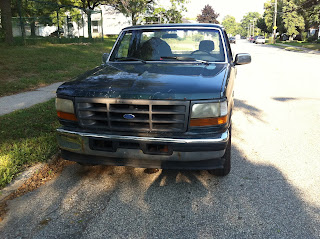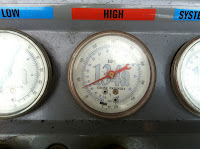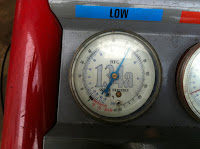For all of you that are new to the two-car lifestyle, here are some helpful hints and procedures to keep your car in good shape while hibernating for the winter.
 |
| Storing a vehicle for a long time is like committing murder against your vehicle. Paint fades, tires flatten, rubber dries. |
When preparing to store your vehicle for the winter, remember that inside storage is always the best if available. The outside elements will take their toll on your car, sometimes more than simply driving it. The first thing to do is to select a dry storage facility where your vehicle can hibernate in peace for the winter months. Even if it is inside, you will still want to cover it, so purchase a good quality car cover that fits your car correctly and covers everything.
Here are some basic steps:
1. Stabilize the fuel.
Gasoline is a light petroleum product infused with alcohol. As we all know, if we leave rubbing alcohol open, it will eventually evaporate and only water will be left, then the water evaporates and there is nothing but debris from the minerals in the water used to manufacture the alcohol. The same holds true for gasoline. When the alcohol evaporates from gasoline, it is not combustible in a gasoline engine any more and you will end up with a potentially expensive problem on your hands. Products such as Sta-Bil will help to stabilize the alcohol in the gasoline to keep it fresher longer. Always follow the directions on the label when adding fuel treatments-more does not do any better. After adding the fuel stabilizer, run your vehicle to operating temperature to ensure that all of the previous pure fuel is purged from the pipes and hoses, all the way through to the fuel injectors.
2. Test the coolant
Be sure to test the coolant for effectiveness. Your antifreeze will become less potent over time and can actually become so cold that it will freeze. Freezing water in an engine will expand through cooling ports and actually break iron, so your engine block can be in trouble if the antifreeze is not up to snuff. If it is not effective to at least -20 Fahrenheit, then flush the system and refill with a 50/50 blend of antifreeze and distilled water.
3. Grease and oil.
You don't want old oil sitting in your engine for an extended period of time. Granted, oil does not lose viscosity over time by sitting, but it will become corrosive from the chemical byproducts of combustion. This corrosive nature will eat away at aluminum, copper, and iron engine components over time. Change the oil before storage. Be sure to lubricate all chassis points as well. Sometimes, water infiltration can freeze in suspension components and will expand just like bad antifreeze in an engine block, causing premature failure of components. By greasing the lubrication points, the water is forced out and replaced with grease to keep everything fresh and healthy. While you're under the car greasing and changing the oil, grab your trusty can of WD-40 and go to town spraying it on the underside of the car. Spray in the small holes in the unibody or frame, on the exhaust components (after they cool), and inside of the door sills. WD-40 is actually a water displacing agent, so it will seal and prevent water from infiltrating the steel components and it will prevent rust and corrosion.
4. Find it a home and put it on stands.
Suspension components, although not being worn from use, will become worn if sitting with constant weight on them for an extended period of time. By removing the weight from the springs and pivot points, they will remain fresher longer. Jack the vehicle up with a good hydraulic jack near the center of the front or the center of either side. Make sure both wheels are level, and place jack stands under the frame or unibody with a few oil-soaked rags to insulate between the jack and the frame. By soaking the rag in oil, you will prevent water infiltration and protect the vehicle from scratches caused by direct metal-on-metal contact.
5. Open the hood and leave it open.
Critters like dark places to hide and live during the winter. Under the hood of the car is a multitude of nooks and crannies that squirrels, woodchucks, and mice would love to call home. By opening the hood during storage, you provide less homes for these little creatures to live and hibernate. Going back to my grandmother again, she lost a 1982 Dodge 400 convertible to a mouse nest under the hood. My grandfather backed it out of the barn in the spring and it engulfed in to flames, burning to the ground. Be sure to inspect it in the spring for nests and debris that could be flammable!
6. Remove the battery
Batteries contain water, which can freeze during the cold months. When water freezes, we all know what happens: it expands and has the power to break iron. Batteries are no different, but they are made of plastic. They will certainly rupture and leak acid on to the underside of the car if frozen. Watch this video to see what happens with only a 32% concentration of hydrochloric acid reacting with steel wool:
http://www.youtube.com/watch?v=lSmcwzTF_6Y
The reaction is similar to what will happen when sulfuric acid reacts with the steel under the battery tray. Remove the battery and put it in the house somewhere warm. Contrary to popular myth, the battery will not discharge if stored on concrete. However, some batteries have traces of sulfuric acid on their bodies, so you'll want to store it on a piece of scrap wood for the winter.
7. Kiss it goodnight, seal it, and cover it up.
It is important to close all of the windows to keep debris out. You don't want to come back to a dirty and dusty car, so close it up tight. This also prevents moisture from infiltrating your interior and causing musty smells and mold. When covering it, be sure to cover all of it, including the tires. Any part of the car exposed will collect dust and moisture which acts like sandpaper on the paint. Never cover it with a cheap tarp, as the plastic material will not allow the moisture to escape. You will want a good quality car cover that can breathe and keep the dust off.
 |
| Storing your vehicle properly is the key to having a true classic to enjoy in the summer months. |
For any questions about storing your vehicle for the winter, repairing your vehicle, or automotive questions in general email me at DIYfixyourcar@gmail.com















